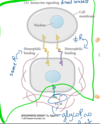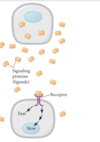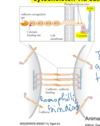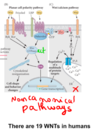Midterm 1 Flashcards
1
Q
define haploinsufficiency
A
- when one functional copy of the gene is NOT enough to provide enough proteins for normal function
2
Q
define fertilization
A
- fusion of sperm and egg to form a zygote

3
Q
define cleavage
A
- Rapid cell divisions dividing the zygote cytoplasm into many progressively smaller cells called Blastomeres
- NB: no increase in volume
- by the end of cleavage, the blastomeres would have formed a sphere called blastula
4
Q
what are the main patterns of cleavage?
A
- Holoblastic: complete cleavage; the entire egg is divided into smaller cells (mammals)
- Meroblastic: only part of the egg is divided and destined to form the embryo and the other part becomes the yolk (source of nutrition) (chicks)
- the yolk rich pole is called the vegetal pole and the embryonic side is called the animal pole
- Centrolecithal: is a form of meroblastic cleavage in which the yolk is in the center of the egg (fruit flies)

5
Q
define gastrulation
A
- period of extensive cell rearrangement
- the stage in which the three germ layers form that will interact to form the organs

6
Q
what are the requirements to meet to make gastrulation happen?
A
- EMT: epithelial to mesenchymal transition
- different types of cell movement
- formation of germ layers
- formation of the notochord
7
Q
describe EMT
A

8
Q
describe the different types of cell movement
A
- Invagination
- Involution
- Ingression
- Delamination
- Epibody

9
Q
How are cells divided during gastrulation?
A
- ectoderm
- mesoderm
- endoderm
- germ cells

10
Q
why is the formation of the notochord important?
A
- The notochord induces the formation of the nervous system
- the notochord forms from the mesoderm

11
Q
define organogenesis
A
- resulting cell differentiation from chemical signals exchanged between cells of the germ layers
- ends in the formation of different organs
12
Q
define the larval stage
A
A sexually immature organism
in order to become sexually mature, the larva needs to undergo metamorphosis
the adult stage is the shortest stage with the sole purpose of reproduction( life may end after giving birth)
13
Q
define specification
A
- when a cell is committed to a given fate but this commitment can be reversed by changing the environment
- refers to a cell’s ability to differentiate in a neutral environment
- to check isolate cell and culture in a basic medium–> cell should differentiate

14
Q
define cell determination
A
- The commitment to a given fate is irreversible
- the cell will differentiate to it’s committed fate regardless of its location ( a different part of the embryo or in culture)

15
Q
define differentiation
A
- development into a specialized cell type
- At this stage, the cell is overtly a certain type at a biochemical and a functional level
16
Q
describe the 2 types of specification
A
- Autonomous speciation: blastomeres acquire determination factors (determinants) from the egg cytoplasm as they divide. Nearby cells usually differentiate into the same thing since they are located next to each other. Even when isolated, the cells divide and become ciliated in time
- Conditional specification: specification comes from signals released from nearby cells. An intact 4-cell embryo from a pluteus larva can be isolated into 4 and produce a full but smaller organism.






















